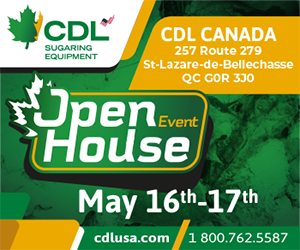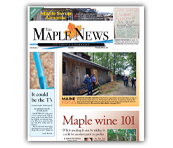BACK TO HOME
Tapping & Tubing
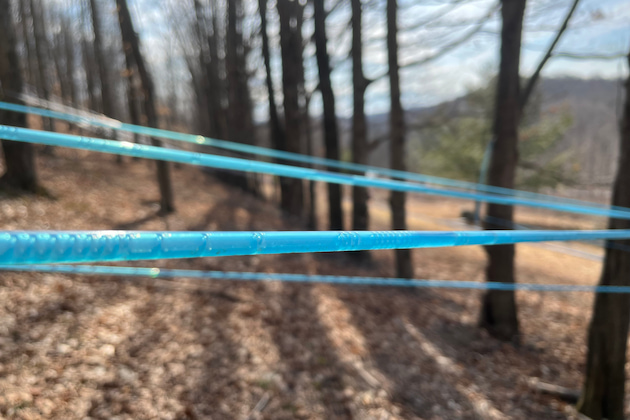
Many sugarmakers sticking with 3/16 tubing
Peter Gregg | March 29, 2023
BOW, N.H.—The reputation of 3/16ths tubing has taken a beating the past couple of years, with sugarmakers gloriously ripping it out of their woods and declaring it a short lived fad.
But there are plenty of sugarmakers that have stuck with the natural vacuum technology, and say that it works for them, and is effective in getting high vacuum from gravity instead of a pump.
The key? Lots and lots of slope.
“Yes it seems the better the slope the better it works and less likely it is to plug up,” said Brandon Daniels of Daniels Pure Maple Syrup in Grassy Meadows, W.V.
Daniels is something of a 3/16ths guru in the Mountain State, where the narrow tubing still rules.
“We are blessed to be able to tap trees on eight properties and we have 2,500 taps on CDL 3/16 natural flow vacuum,” he said.
West Virginia has some of the steepest slope in the Maple Belt, which is why, anecdotally, the technology seems to work there.
[ MORE ]
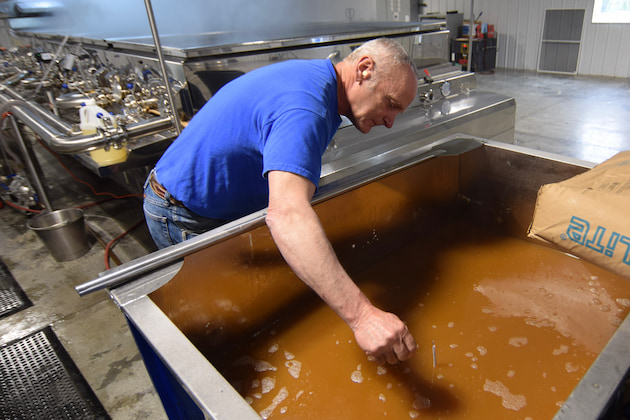
Tips from Glenn: Goodrich shares his secrets
Peter Gregg | February 14, 2023
PLYMOUTH, N.H.—Sugarmaking legend Glenn Goodrich was the featured speaker at the NHMPA annual meeting on Jan. 21, offering advice on tapping, vacuum and boiling.
“Getting a true round hole in the trees is essential,” Goodrich told producers on his tapping methods. Goodrich has a 160,000-tap operation in Eden, Vt. and Cabot, Vt. and is recognized as one of the U.S.’s premier sugarmakers, winning countless awards.
Goodrich says as he and his crew of tappers march from tree to tree, he estimates he taps a tree in 35 seconds before moving to the next one.
“I fire the drill to the highest speed the drill can spin,” he said, before sinking it into the tree at a maximum depth of no more than 2 inches, or sometimes just one inch on marginal trees.
After the hole is drilled, he uses a nylon-headed tapping mallet to knock in a spout, but with not too much force.
“It’s all in the wrist,” he said. “We’re not knocking in the spout with a 24-ounce Estwing hammer as hard as we can. Don’t do that.”
He said most taps usually get “six hits,” with the mallet.
Once he’s tapped, the vacuum generally runs continuously at the farm.
“I will shut off the pumps only if I know the trees will be frozen for at least 10 hours,” he said. [ MORE ]
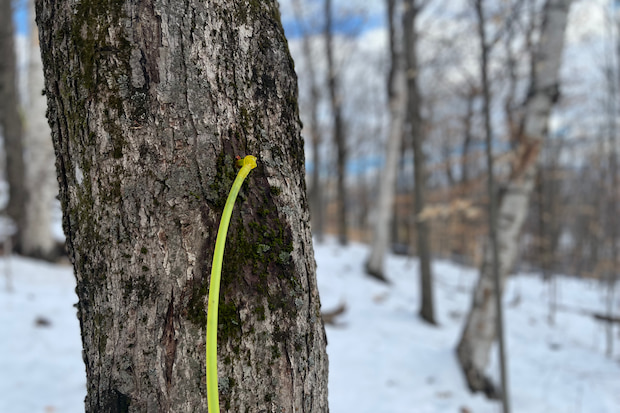
What to do about weepy tapholes?
Peter Gregg | February 10, 2023
FAIRFIELD, Vt.—What to do about weepy tapholes?
As sugarmakers across the U.S. race into the woods this week during an unusual warm-up, some are scratching their heads over a common phenomena—sap leaking out of the taphole and spreading around the trunk.
Expert tappers generally agree that the leaks are caused by poorly drilled holes.
“Wobbly or oval holes, I would say is the cause,” said Evan Branon of 80,000-tap Branon Family Maple Orchards in Fairfield, Vt. Branon is the inventor of the Precision Tapper, a drill attachment sold by CDL that helps the sugarmaker drill consistent and straight holes in the tree.
Still, for those who don’t own that equipment, sugarmakers can ensure proper holes by using good technique.
“We always want to use two hands to steady the drill,” said 160,000-tap sugarmaker Glenn Goodrich of Goodrich Maple Farms in Cabot, Vt. who led a seminar on tapping at the New Hampshire maple school last month.
Goodrich said that if a sugarmaker finds a weepy hole after drilling, he/she should not go back and pound the tap in harder with the mallet.
“Just leave it alone and check back on it in a few days,” he said, suggesting that the hole oftentimes will seal up on its own.
[ MORE ]
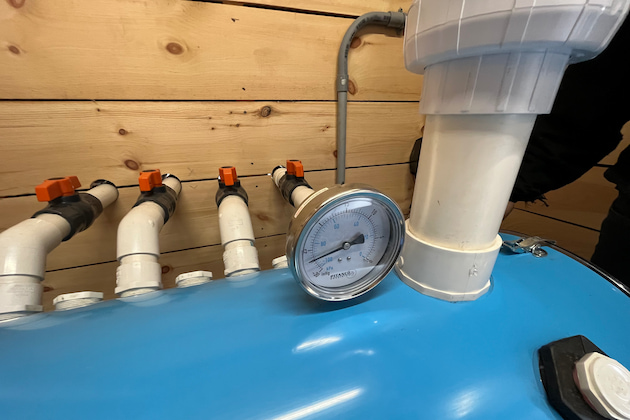
Maxed out sap? Trees can handle it, say researchers
Peter Gregg | January 5, 2023
UNDERHILL CENTER, Vt.—Are the trees maxed out on sap production? Not yet, say experts.
With several sugarmakers starting a season in November or December and pulling sap from the same trees and same tapholes all the way to late April with high vacuum running every single day, questions are being asked about the ultimate sap capacity of a tree.
“Are we at the limits of extraction? No, I don’t think we are there yet,” said Dr. Timothy Perkins, director of the UVM Proctor Maple Research Center, during an online Q&A session last month.
Dr. Abby van den Berg, also of the Proctor Center, concurred.
“There is a question of the reservoir—we don't know what is there,” she told sugarmakers.
“We think we are taking a reasonably small percentage of the tree’s reserves.” [ MORE ]
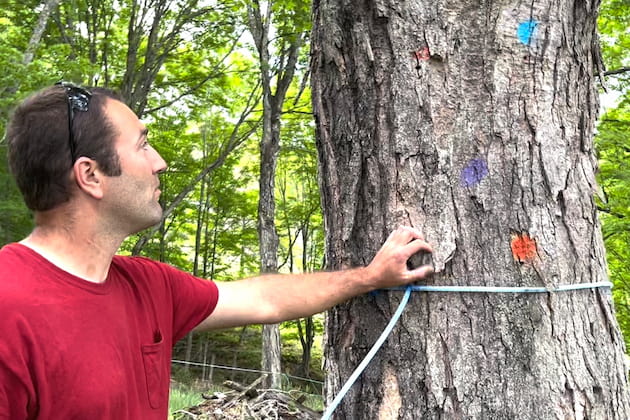
Sugarmaker endorses “pattern tapping”
Peter Gregg | December 22, 2022
DUNMORE, W.V.—Adam Taylor of Frostmore Farm in Dunmore, W.V. practices sequential or “pattern” tapping by marking the tapholes from year to year with colored paint.
“We tend to move in the same direction every year, always to the right, so we dont get partitioned wood,” he said.
Taylor says he also likes to tap “really high in the air” to avoid tapholes from long ago where buckets were once hung from this tree.
“We get good sap quality every year,” Taylor said. [ MORE ]
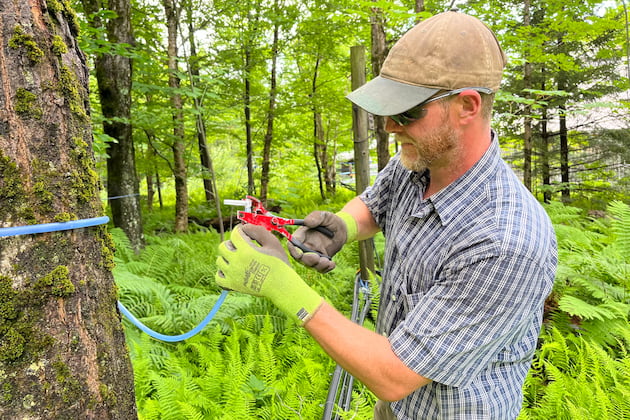
Early spout deployment ok'd by Proctor researchers
T.D. Perkins, W.T. Bosley, A.K. Van Den Berg, S.J. Abair | September 12, 2022
UNDERHILL CTR.—It is well recognized that spout and dropline sanitation heavily influence sap yields in maple tubing systems.
The drop, including both the tubing and spout collectively, accounts for almost 90% of the sanitation effectiveness in terms of sap production, while the lateral line and mainline have only a small influence on yield in terms of sanitation.
Of this, the spout is by far the most important component, although annual replacement of the spout alone is not enough to achieve maximum production on used droplines.
[ MORE ]
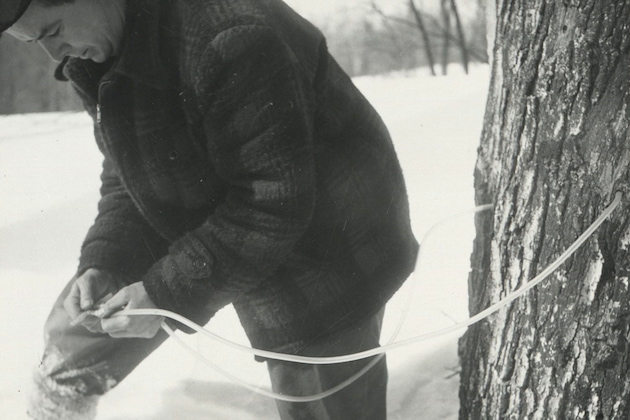
From Pails to Pipelines:
Paul Post | June 26, 2022
BURLINGTON, Vt.—If the maple world ever creates its own version of Mount Rushmore, the tubing pioneers from the 1950s would make excellent candidates.
Nelson S. Griggs and George B. Breen of Vermont, and Robert M. Lamb of Central New York, led the way with development of plastic tubing for sap collection, which laid the foundation for today's highly-efficient, modern production systems.
Historian Matthew M. Thomas, PhD, discussed their work and the evolution of sap gathering in a fascinating online presentation, "From Pails to Pipelines: The Origins of Plastic Tubing in the Maple Syrup Industry."
Thomas created the website MapleSyrupHistory.com and has authored two books, "A Sugarbush Like None Other" and "Maple King: The Making of a Maple Syrup Empire."
[ MORE ]
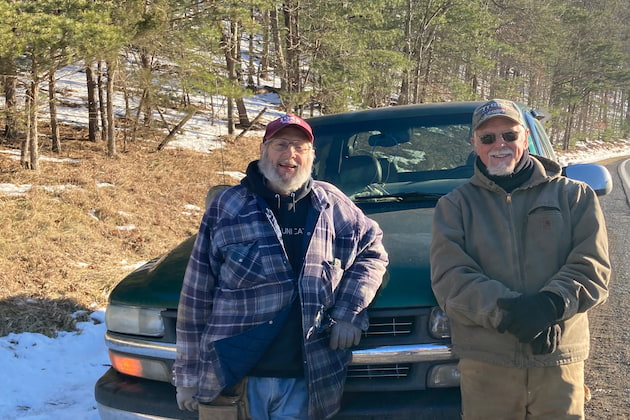
Maple 101: Expanding through tapping tenure agreements
Mike Rechlin | June 1, 2022
FRANKLIN, W.V.—The issue of tree access can be problematic for many maple producers.
Just like leasing pasture to support a growing herd of cows, many maple producers lease trees to support increased production.
This allows syrup producers to expand production beyond the forest resource they have available on their own lands.
Depending on the demand for trees to lease, a landowner can expect from $0.50 to $1.00 per tree.
A good sugarbush can have 70 taps per acre, realizing an annual income to the landowner of between $35 to $70/acre.
[ MORE ]
















